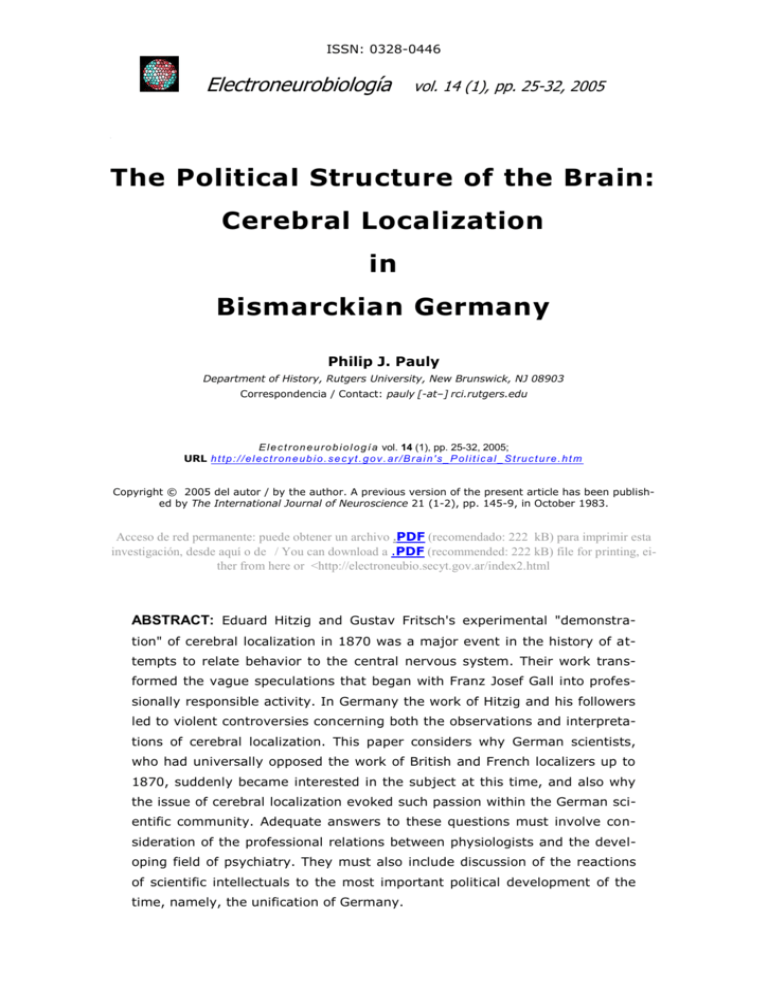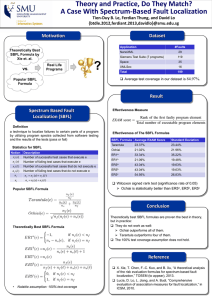The Political Structure of the Brain: Cerebral Localization in
advertisement

ISSN: 0328-0446 Electroneurobiología vol. 14 (1), pp. 25-32, 2005 keywords -: Franz Josef Gall phrenology Eduard Hitzig Gustav Fritsch Friedrich Goltz Hermann Munk Jacques Loeb cerebral localization brain electrostimulation excitability of the cerebral cortex central nervous system behavior localizers localizationism antilocalizationism Kultur Reichsbank Bismarckian Germany unification history physiology physiologists psychiatry brain-mind consciousness psychology neurology neurological theories nineteenth century FrancoPrussian War Bogumil Goltz's Die Deutschen (1860) . The Political Structure of the Brain: Cerebral Localization in Bismarckian Germany Philip J. Pauly Department of History, Rutgers University, New Brunswick, NJ 08903 Correspondencia / Contact: pauly [-at–] rci.rutgers.edu E l e c t r o n e u r o b i o l o g í a vol. 14 (1), pp. 25-32, 2005; URL h t t p : / / e l e c t r o n e u b i o . s e c y t . g o v . a r / B r a i n ' s _ P o l i t i c a l _ S t r u c t u r e . h t m Copyright © 2005 del autor / by the author. A previous version of the present article has been published by The International Journal of Neuroscience 21 (1-2), pp. 145-9, in October 1983. Acceso de red permanente: puede obtener un archivo .PDF (recomendado: 222 kB) para imprimir esta investigación, desde aquí o de / You can download a .PDF (recommended: 222 kB) file for printing, either from here or <http://electroneubio.secyt.gov.ar/index2.html ABSTRACT: Eduard Hitzig and Gustav Fritsch's experimental "demonstration" of cerebral localization in 1870 was a major event in the history of attempts to relate behavior to the central nervous system. Their work transformed the vague speculations that began with Franz Josef Gall into professionally responsible activity. In Germany the work of Hitzig and his followers led to violent controversies concerning both the observations and interpretations of cerebral localization. This paper considers why German scientists, who had universally opposed the work of British and French localizers up to 1870, suddenly became interested in the subject at this time, and also why the issue of cerebral localization evoked such passion within the German scientific community. Adequate answers to these questions must involve consideration of the professional relations between physiologists and the developing field of psychiatry. They must also include discussion of the reactions of scientific intellectuals to the most important political development of the time, namely, the unification of Germany. E l e c t r o n e u r o b i o l o g í a vol. 14 (1), pp. 25-32, 2005 RESUMEN : La "demostración" experimental de localizaciones cerebrales, lograda por Eduardo Hitzig y Gustavo Fritsch en 1870, constituyó un acontecimiento de primera magnitud en la historia de los intentos por relacionar comportamientos con sistema nervioso central. Su labor transformó las inciertas especulaciones que habían comenzado con Francisco José Gall en una actividad profesionalmente responsable. En Alemania el trabajo de Hitzig y sus continuadores llevó a violentas controversias tanto respecto a las observaciones cuanto a las interpr etacions de la localización cerebral. La presente investigación consi dera por qué los científicos germanos, que se habían opuesto universa lmente al trabajo de los localizadores británicos y franceses hasta 1870, en ese momento pasaron bruscamente a interesarse en el asunto; y, asimismo, por qué la cuestión de la localización cerebral despertó semejante pasión en la comunidad científica germana. Las respuestas adecuadas para estos interrogantes tienen que incluir la consideración de las relaciones profesionales entre los fisiólogos y el campo de la psiquiatría en desarrollo. Deben también incluir el estudio de las reacciones de los intelectuales activos en las ciencias al más importante giro político del momento: la unificación de Alemania. ------------- In 1870 Eduard Hitzig and Gustav Fritsch announced their discovery of the excitability of the cerebral cortex. More importantly, they also claimed that within the cortex there were anatomically well-defined centers directing the motions of different body parts. Over the next twenty years, the controversies in Germany over this issue of cerebral localization were so violent that William James (1890, 1:46) commented that "the subject of localization of functions in the brain seems to have a peculiar effect on the temper of those who cultivate it experimentally." Experimenters produced a mass of obscure and contradictory observations; while positions overlapped on individual issues, there was a sharp line between localizers and their opponents. The one side emphasized boundaries, order, and the regularity of brain function; the other stressed compensation, adaptation, cooperation, and the activity of the organism as a whole. This paper considers why German interest in cerebral localization began so suddenly in 1870, and why the topic aroused such passion. The controversialists themselves emphasized differences in technique. The rapid growth of biomedical research in Germany after 1850, and the general con- 26 Pauly – The Political Structure of the Brain: Cerebral Localization in Bismarckian Ge rmany tentiousness of the German academic system, are also relevant themes. Recent work in the history of neurophysiology, however, has opened up another possibility. A number of scholars (Young, 1970; Geison, 1978; Shapin, 1979) have discussed the broad political implications that neurological theories had throughout the 19th century, and there has been particular interest in the relation between the English phrenological debates of the early part of the century and social and political issues. What follows is a brief exploration of the political implications of the "new phrenology," as it was sometimes called, in the rather different context of Bismarckian Germany. There the issue of cerebral localization was closely tied to contemporary tensions regarding the political and social role of the middle class intellectual elite. Antilocalizers tended to be in "pure" scientific disciplines such as physiology, and identified themselves with Kultur, the spiritual bond they felt united the true Germany. Most localizers, on the other hand, were clinical professionals (largely in the field of psychiatry) who saw themselves as part of the highly structured bureaucracy of the new Reich, established under Prussian domination in 1871. This contrast will be developed through examination of the social backgrounds, intellectual interests, and professional aims of the two leading antagonists in the cerebral localization debates, Eduard Hitzig and Friedrich Goltz. While the positions were extreme, they represent ideal types against which others involved can be compared. Although ethnically Jewish, Eduard Hitzig (1838-1907) was, as his obituarist noted, the quintessential arrogant Prussian (Wollenberg, 1908; see also Clarke, 1972). He grew up in a Berlin household deeply involved in the construction of the visible Prussian state. His grandfather Julius Hitzig, who converted to Christianity in 1799, worked to develop the Prussian criminal code in the 1830s. His father, who became president of the Royal Academy of Arts, was one of the major architects of Imperial Berlin, designing the Reichstag, Reichsbank, Bourse, and many houses for the new urban upper classes. Eduard Hitzig received an M.D. from the University of Berlin in 1862, and took advantage of the recent opening of army medical practice to university graduates by becoming physician to the Berlin garrison hospital. His involvement with the army bureaucracy led him to his discovery. In 1867 he developed apparatus to generate constant electrotherapeutic currents of over 100 volts, and tested these heroic methods on his hospital patients (Hitzig, 1867, 1869). On one occasion currents sent through the skull of a patient produced involuntary eye movements, leading Hitzig to ask whether the stimuli were central or peripheral, and thus to test the excitability of the cortex (Hitzig, 1904, 1:14). With the help of the anatomist Gustav Fritsch he instituted experiments on dogs, and they were able to demonstrate (1870) 27 E l e c t r o n e u r o b i o l o g í a vol. 14 (1), pp. 25-32, 2005 that electrical stimulation of different cortical areas led to distinct motor responses. Further results were delayed because Hitzig soon left Berlin to serve at the seige of Nancy in the FrancoPrussian War, for which he received an Iron Cross. Hitzig's thinking was permeated with Prussian bureaucratic concepts. He was never so open as his partner Fritsch, who compared the motor center directly to a government minister, and claimed (1884) that compensation after removal of a center was similar to continuation of the bureaucracy's work when the minister was on vacation. But neural organization from Hitzig's standpoint was almost identical to the organization of the bureaucracy. His model of the nervous system involved sharp divisions of authority, both vertically from the center of abstract thought in the frontal lobes, to the motor centers, to the efferent nerves; and horizontally, with well marked topographical divisions of responsibility among the various motor centers, or, as he called them, "provinces." (Hitzig, 1886; Hitzig, 1904, 1: 36-62, 114-158, 230-237). His strongest attack (1887, p. 129) was to brand his opponent (in this case Goltz's student Jacques Loeb) "an apostle of lawlessness," someone who would subvert the order that cerebral localization had established. Localization both represented bureaucratic order and was a means for promoting that order in concrete ways. It gave crucial support to the argument that mental illnesses were diseases of the brain, thereby bringing insanity more firmly within the boundaries of medicine. Men trained in anatomy, physiology, and pathology of the brain were able to claim authority over the new professorships of psychiatry and the growing complex of mental institutions. Hitzig was appointed director of the Burgholzli Cantonal Asylum and professor of psychiatry at the University of Zurich in 1875 (Ackerknecht, 1978). His fight against the democratic cantonal government to put complete control of the asylum under the medical director resulted in political uproar and libel suits, and he returned to the more orderly Germany as professor of psychiatry and clinic director at the University of Halle. Declining to move to Austria-Hungary to replace Theodor Meynert, he remained at Halle to exert a major influence on German psychiatry to the end of the century. Friedrich Goltz (1834-1902), the major German opponent of localization, had sharply contrasting social origins, intellectual aims, and professional interests. Goltz was born not in Berlin but in the town of Poznan (Posen), and grew up in an area where German, Polish, Jewish, and Russian influences intermingled (Ewald, 1903; Rothschuh, 1972). The strongest influence on his early years was his uncle Bogumil, a well known popular writer and cultural nationalist. Bogumil Goltz's Die Deutschen (1860) emphasized that 28 Pauly – The Political Structure of the Brain: Cerebral Localization in Bismarckian Ge rmany one of the greatest advantages the Germans had over other peoples such as the French was that Germany was culturally united but politically fragmented, and therefore the German sense of nationhood was not distorted by the unfortunate aggressiveness and worldliness of the modern state. Friedrich Goltz studied anatomy and physiology at Konigsberg with Hermann Helmholtz. However, he soon rejected the physicalistic reductionism of the Berlin "school" of physiology, and even more their reliance on delicate and complex instrumentation, in favor of simple observations and experiments in the tradition of Johannes Mueller. Goltz established himself within the physiology profession in the 1860s with studies on the "adaptive capacities" of decerebrated frogs (Goltz, 1869), emphasizing that the behavior of such organisms was much more complex than a mere combination of reflexes. In 1872 Goltz became professor of physiology at the new University of Strasbourg (Strassburg), created as part of Bismarck's campaign to Germanify the new province of Alsace that had been acquired in the recent war with France (Craig, 1972, pp. 209-221, 379-393). Along with the other Strasbourg professors, Goltz saw himself as a missionary of German Kultur (Goltz, 1888). The example university professors would provide through their devotion to scholarship would gradually impress upon the Alsatians the excellence of their "original" German heritage; at the same time the meaning of Germanness itself would be broadened through incorporation of the local and French traditions. The professors believed that the initial antagonism of the Alsatians towards the radical political change of 1870 would gradually fade as time passed and an atmosphere of cooperation took its place. The major obstacle to this, in the opinion of Goltz and his colleagues, was the direct political and military control being exercised over the area by Berlin, and even more the "Kommando-ton" and overbearing attitude of the Prussian bureaucrats (Waldeyer-Hartz, 1921, p. 170; Craig, 1972, pp. 379-393). Goltz's Strasbourg experience thus strongly reinforced a number of his earlier convictions: the importance of cooperation among ethnic groups, his allegiance to physiology as a pure science, the separation between culture and political power that his uncle had emphasized, and the provincial's resentment of central bureaucratic interference. It is not surprising that, as Goltz pursued research in brain physiology, he began to oppose the localization concepts of Hitzig, Fritsch, and other Berliners such as Hermann Munk. Goltz considered Hitzig's demonstration of cortical excitability interesting but behaviorally irrelevant, and argued that motor defects in the immediate aftermath of ablations were merely due to trauma. Only the perma- 29 E l e c t r o n e u r o b i o l o g í a vol. 14 (1), pp. 25-32, 2005 nent results of ablations were significant for understanding the normal functions of the cortex. While large ablations of both hemispheres in dogs produced visual disturbances, general sensory weakness, and lowering of intelligence, there was never the total paralysis one would expect if a real "controlling center" had been removed (1881, pp. 1, 75-128, 159-173). Goltz recognized that his results were less certain and more variable than the welldefined claims of localizers, but felt the complexity of life should not be oversimplified. He compared cerebral localization charts to the arbitrary boundaries among the old German states, and argued that such sharp "political" boundaries could not apply to a living entity like the brain (1881, p. 102; 1885, p. 372). The closest analogy in his view would be a map of vegetation (or, though he did not say so, of European nationalities), where populations overlapped and the dominant character changed only gradually. What was important was the extent of adaptability and accommodation, and the insignificance of boundaries. While there was no experimentum crucis, localization held the field as the debate wound down around 1890. The law and order evident in localization theory had greater appeal to the German medical audience than Goltz's emphasis on cooperation. More specifically, however, Goltz had little positive to offer to physicians; in the face of localization theory's promises of definite diagnoses, Goltz appeared to be a carping critic who held back progress and undermined the authority of the medical profession (Ewald, 1903, p. 14). His experimental program was not developed further until the work of Karl Lashley (1929), in the very different context of American academic psychology. For German intellectuals the Bismarckian era was a period of rapid change. Unification through military force seemed to alter the relative positions of culture and power as national characteristics. Industrialization brought social dislocation and the perceived Marxist threat to law and order. University graduates were taking on new professional roles within the bureaucratic system. Hitzig and Goltz represent two types of reaction to these changes. While Hitzig was in the vanguard of nationalistic and bureaucratizing tendencies, Goltz sought to mitigate nationalism and to maintain older cultural ideas. Their concepts of brain function reflected this division; and in part at least, their debate was about politics. Not all Germans concerned with brain physiology had interests and attitudes as sharply defined as those of Hitzig and Goltz. But the polarity described above provides a framework for examining the attitudes of other figures toward localization, and more generally for studying the interconnections between physiological and political thinking in late 19th century Germany. 30 Pauly – The Political Structure of the Brain: Cerebral Localization in Bismarckian Ge rmany References Ackerknecht, E. A., "Gudden, Huguenin, Hitzig. Hirnpsychiatrie im Burgholzli 18691879." Gesnerus, 1978, 35, 66-78. Clarke, E., (Julius) Eduard Hitzig. In: Dictionary of Scientific Biography, (Vol. 14). New York: Scribner's, 1972. Craig, J. E., "A Mission for German Learning: The University of Strasbourg and Alsatian Society, 1870-1918." Unpublished doctoral dissertation, Stanford University, 1972. Ewald, J. R., "Friedrich Goltz." Pfluegers Archiv, 1903, 94, 1-64. Fritsch, G., "Herrn Prof. Goltz's Feldzug gegen die Grosshirnlocalisation nach Berlin. Berliner klinische Wochenschrift, 1884, 21, 299-301. Fritsch, G. & Hitzig, E., "On the electrical excitability of the cerebrum" (1870). In G. von Bonin, transl., Some papers on the cerebral cortex. Springfield, Illinois: Thomas, 1960. Geison, G. L. Michael Foster and the Cambridge school of physiology. Princeton: Princeton University Press, 1978. Goltz, B., Die Deutschen (2 vols.). Berlin, 1860. Goltz, F. L., Beitrage zur Lehre von den Functionen der Nervencentren des Frosches. Berlin, 1869. Goltz, F. L., Ueber die Verrichtungen des Grosshirns: Gesammelte Abhandlungen. Bonn, 1881. Goltz, F. L., "Ueber die moderne Phrenologie." Deutsche Rundschau, 1885, 45, 263283, 361-375. Goltz, F. L., Rede zur Gedenkfeier des verewigten Stifters der Universitat weiland Seiner Majestat Kaiser Wilhelms. Strasbourg, 1888. Hitzig. E., "Ueber die Anwendung unpolarisirbarer Elektroden in Elektrotherapie." Berliner klinische Wochenschrift, 1867, 4, 404-406. [Hitzig, E.], "Verhandlungen arztlichen Gesellschaften." Berliner klinische Wochenschrift, 1869, 6, 420. Hitzig, E., Von den Materiellen der Seele. Vortrag gehalten im Frauen-Verein zur Armen- and Krankenpflege zu Halle a. S. am 25 Marz 1886. Leipzig, 1886. Hitzig, E., "Erwiderung dem Herrn Professor Zuntz." Pfluegers Archiv, 1887, 40, 128136. Hitzig, E., Physiologische und klinische Untersuchungen ueber das Gehirn: Gesammelte Abhandlungen (2 vols.). Berlin, 1904. James, W., The principles of psychology (2 vols.) [New York, 1890]. New York: Dover Publications, 1950. Lashley, K. S., Brain mechanisms and intelligence. Chicago: University of Chicago Press, 1929. 31 E l e c t r o n e u r o b i o l o g í a vol. 14 (1), pp. 25-32, 2005 Rothschuh, K. E., "Friedrich Leopold Goltz". In: Dictionary of scientific biography (Vol. 14). New York: Scribner's, 1972. Shapin, S., "The politics of observation: Cerebral anatomy and social interests in the Edinburgh phrenology disputes." In: Roy Wallis, ed., On the margins of science, Sociological Review Monograph No. 27, 1979. Waldeyer-Hartz, W. von, Lebenserinnerungen. Bonn: Friedrich Cohen, 1921. Wollenberg, R., "Eduard Hitzig." Archiv fur Psychiatrie and Nervenkrankheiten, 1908, 43, iii-xv. Young, R. M. Mind, brain, and adaptation in the nineteenth century. Oxford: Clarendon Press, 1970. ------------------------------ revista Electroneurobiología ISSN: 0328-0446 32








